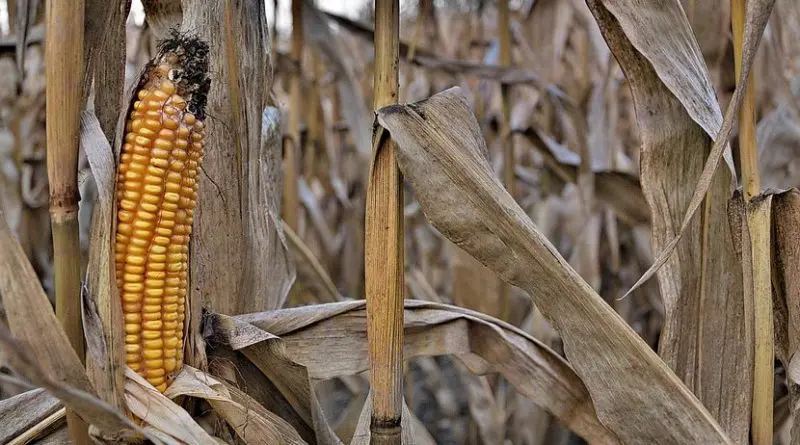Philippines: Corn Fields Dry Up As South Grapples With El Niño
By BenarNews
By Jeoffrey Maitem
Elderly farmer Avelino Jacinto surveyed a field that was once covered in greenery, but had recently transformed into a patch of cracked earth.
Jacinto, 73, was staring at the early impacts of El Niño, a weather phenomenon that causes warming of sea-surface temperatures in the Pacific, which could unleash droughts and shrink the economic performance of one of Southeast Asia’s robust economies.
Agriculture has been the lifeblood of this town in the volatile southern Philippines for years. But this year’s extremely dry weather – forecast to worsen as the nation enters its summer months – is not only threatening livelihoods but also food security.
“These corn I am showing you are now worthless,” Jacinto told a BenarNews reporter as he visited his five-hectare (12-acre) farm in South Cotabato province last week. “I cannot do anything but accept our loss.”
Not far from Jacinto’s farm, a river that used to provide irrigation for thousands of hectares (acres) of farmland in nearby towns had dried up or was slowly turning to brown mud.
El Niño, which means “the boy” in Spanish, occurs every few years. It produces scorching weather in Asia and East Africa, but causes flooding in South America, and usually lasts about one year. In the late 1990s, it killed more than 2,000 people worldwide and wreaked havoc on farmlands.
In the town of Lake Sebu, also in South Cotabato, farmers tried to salvage remaining agricultural crops that were damaged as the drought progressed. For many it was a race against time, but the crops that were harvested were of low quality and not going to make the market sale.
“We can only get about one fourth of these crops,” said Roland Samping, 34, as he began harvesting a rice paddy.
Across Mindanao and the eastern parts of the country facing the Pacific, at least five regions are already suffering the early onset of a dry spell, and it is estimated that more than 100,000 farmers will be affected.
The government’s disaster risk office confirmed that five regions in the countryside were already severely hit by a dry spell, with the bulk of more than 100,000 farmers affected in the Bicol and Mindanao regions.
The Climate Prediction Center, which is part of the U.S. National Oceanic and Atmospheric Agency, claimed earlier that the dry spell had strengthened in February as above-average sea surface temperatures rose across the equatorial area of the Pacific Ocean.
Initial reports indicated that almost 150,000 hectares (370,000 acres) of farmland planted to some 233,000 metric tons (513 million pounds) of rice had already been affected, according to the country’s agriculture department.
Amid the potential negative impact of the prolonged dry spell brought about by El Niño, the Manila-based regional lender Asian Development Bank (ADB) on Wednesday slashed its 2019 growth forecast for the Philippines to 6.4 percent.
But Kelly Bird, ADB’s country director, told reporters that although the country’s economic expansion was cut from a previous projection of 6.7 percent, economists expected faster growth this year compared to 2018, largely bolstered by the government’s massive infrastructure spending.
Similarly, the World Bank’s outlook this year on the Philippine gross domestic product (GDP) also went down from 6.5 percent in December 2018 to 6.4 percent, as it flagged several risks, including the El Niño phenomenon, which may cause lower farm output and an uptick in food prices.
With the effects of drought likely to worsen, the government has reactivated the El Niño Task Force to ensure farmers won’t suffer as they did in 2015, when the extreme dry spell struck with much intensity, destroying an estimated 15 billion pesos (about U.S. $288 million) worth of crops and livestock.
Jose Luis Fernandez, the U.N. Food and Agriculture Organization representative in Manila, warned that climate change ultimately impacts food insecurity.
In January, his agency implemented an early warning system for drought in the country, where extreme weather could not only disrupt farm production but also stir strong typhoons.
The intervention aims to safeguard the livelihood of rice farmers in selected areas in Mindanao that have high vulnerability rates and high exposure to drought. At the same time, it will help protect production by providing irrigation systems in areas with dried up water resources.
In 1998, El Niño delivered droughts that wiped almost $5 billion from farm production, causing a 6.4 percent contraction in agriculture, and a spike in food prices in a country where food is the most heavily weighted component of the consumer price index.
“We cannot stop El Niño from happening,” Ernesto Pernia, the socio-economic planning secretary, told reporters this week, as he announced the reactivation of the El Niño task force.
“But as we take a long-term view and look at the lessons from our experiences, we are on a stronger footing to weather it,” he said.

